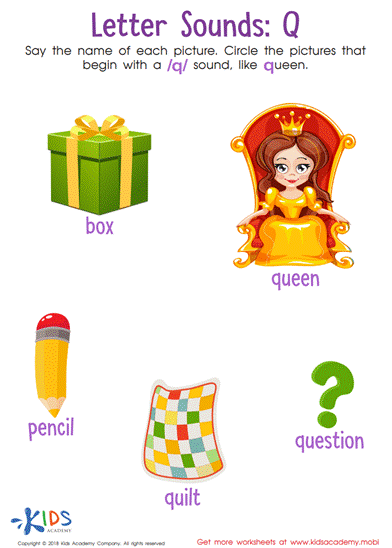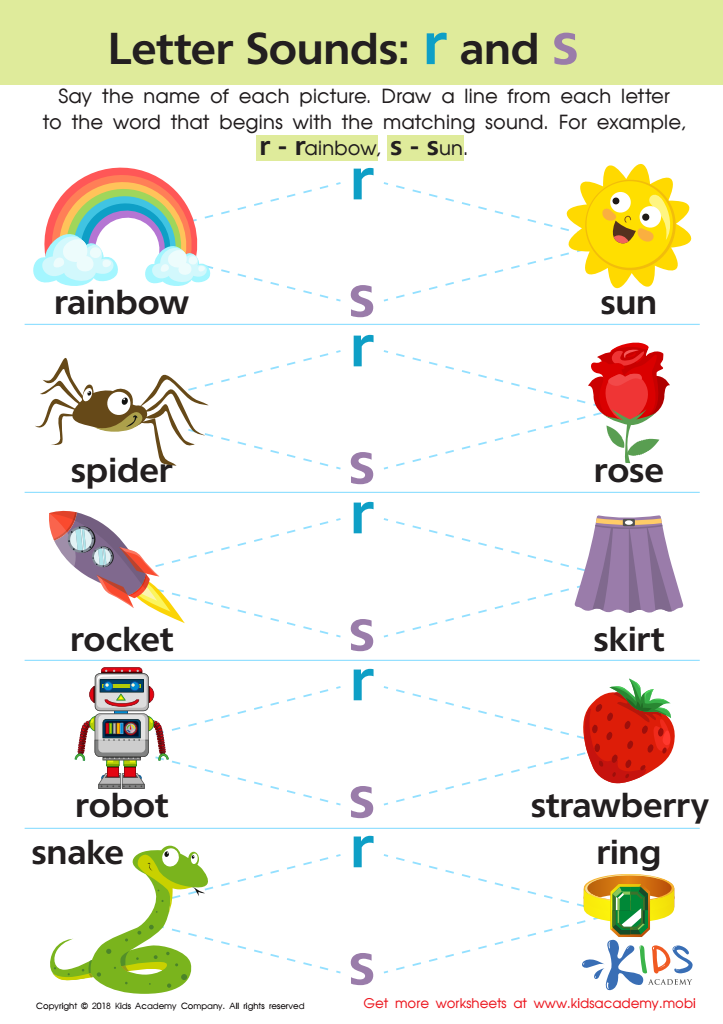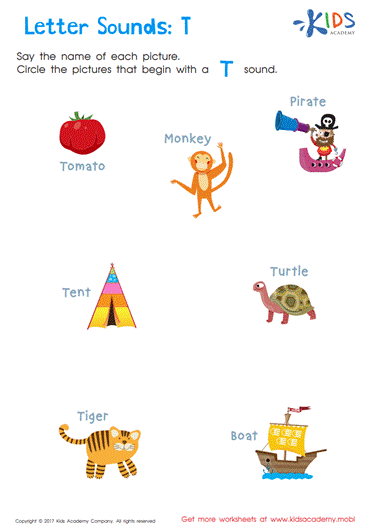-
English
-
English Pre-K
-
Unit 1: Early Literacy Skills
-
ABCs
- Pre-writing Activities
- Letter A
- Letter B
- Letter C
- Letter D
- Letter E
- Letter F
- Letter G
- Letter H
- Letter I
- Letter J
- Letter K
- Letter L
- Letter M
- Letter N
- Letter O
- Letter P
- Letter Q
- Letter R
- Letter S
- Letter T
- Letter U
- Letter V
- Letter W
- Letter X
- Letter Y
- Letter Z
-
Phonological Awareness
- Rhyming Words
- Letter Sounds B, C, D, and F
- Letter Sounds G, H, J, and K
- Letter Sounds L, M, N, and P
- Letter Sounds Q, R, S, and T
- Letter Sounds V, W, X, Y, and Z
- Letter Sounds A, E, and I
- Letter Sounds O and U
- Beginning Sounds
- Matching Letters to Sounds
-
ABCs
-
Unit 2: Vocabulary
-
Common Words
- Sorting Words into Categories
- Color Words
- Verbs and Adjectives
-
Sight Words
- Sight Words 'I' and 'Can'
- Sight Words 'You' and 'Like'
-
Common Words
-
Unit 3: Print Awareness
-
Parts of a Book
- Working with a Book
- Spaces Between Words
- Text and Illustrations
-
Picture Books and Poems
- Picture Book Text Features
- Poem Text Features
- Signs and Labels in the Community
-
Parts of a Book
-
Unit 4: Reading Literature
- Questions About Stories
- Discussing Stories
-
Unit 5: Reading Informational Texts
- Retelling Details in a Text
- Questions About a Text
- Connections Between Events
- Text Features
- Describing Illustrations
-
Unit 1: Early Literacy Skills
-
English Pre-K
-
Math
-
Math for Pre-Kindergarten
-
Logic and Geometry
-
Matching and Sorting
- Same and Different
- Which One Is a Little Different?
- Objects That Go Together
- Sorting by Color and Size
- Sorting The Same Group in Different Ways
- Patterns
-
Shapes
- Shapes in Our Environment
- Naming Shapes Regardless of Size
- Making Shapes in Preschool
- Comparing Shapes
- Relative Positions
- Sorting Shapes
-
Matching and Sorting
-
Early Number Sense
-
Numbers 1–5
- Counting to 3
- Counting to 5
- Arranging Objects up to 3 Objects
- Arranging up to 5 Objects
- Writing Numbers 1–5
-
Numbers 1–5
-
Numbers up to 10
- Counting to 10
- Arranging up to 10 Objects
- Number 0
- Writing Numbers 6–10
- Breaking Down Numbers 6-10
-
Logic and Geometry
-
Math for Pre-Kindergarten
Letter Sounds Q, R, S, and T
In this article, we will be going through activities helping to make learning the four letter sounds Q, R, S, and T fun. These activities are also important for training your child’s phonological awareness, a skill they learn as they prepare for future reading and writing skills. Phonological awareness happens when a child starts recognizing individual sounds, segmenting words into individual sounds (bat: /b/ /a/ /t/), and blending sounds into words.
Recognizing sounds and segmenting words into sounds is the foundation that helps children with future spelling, and subsequently writing, while blending helps with future reading as they can put together the letter sounds they see in each word.
Letter Sound Q
The letter Q is a complex one. In most cases it is followed by the letter U making a “qu'' combination. This combination makes two sounds at once: /k/ and /w/. "Qu" words are not very common in our everyday language. Some of the words that contain this sound combination are: quote, queen, equal, squid, cheque, etc.
Consider offering your child this activity that will have them up and moving. All you have to do is say two words, if the two words start with the letter sound Q, your child should jump, if only one starts with a Q, they should jump on one leg, and if they both don’t start with Q, they stay put. For example, if you say: “question and queen”, they should jump. If you say “quilt and table”, they should jump on one leg, and if you say “rabbit and horse” they should stay still.
In addition, you can print out this “Letter Sounds: Q” worksheet for your child to practice identifying the sound the letter Q makes at the beginning of words. Explain the instructions to your child, have them name each picture, and then circle the ones that begin with the /kw/ sound.
Letter Sound R
The rolling sound of the letter R is one of the hardest for children to pronounce, so it is okay if it takes them time to perfect. Meanwhile, to reinforce your child’s ability to break up a word into sounds, it is important to provide them with opportunities to practice.
One activity you can do together is listen to the nursery rhyme “Row Row Row Your Boat”, and count how many /r/ sounds it has. This activity works not only on the /r/ sound, but is also a revision of the Rhyming Words lesson in this chapter.
Another simple yet fun activity you can do with your child is to place objects in a bag, for example, a paperclip, ruler, eraser, cup, rock, remote, tissue, ribbon, ring, book, rubber band, etc. Take turns picking an object from the bag, naming it, and identifying whether it starts with the letter sound R or not.
Letter Sound S
The /s/ sound is made by the letter S. For the letter S activity, place 6 objects on the table, half of which start with the /s/ sound. Have your child name each one and identify if it belongs to the /s/ sound family or not. Some words that start with the /s/ sound that you can include in your activity are: strawberry, spoon, and safe scissors. Including these everyday objects in the activity helps your child retain the information they've learned.
Since children love activities, here is another one to offer your child. On sticky notes, draw images of things that start with an S. Stick them to your child’s forehead, give them hints on what the object is and have them guess what it is. Some easy to draw examples that start with the letter S are snake, seesaw, snowman, slug, sun, seal, etc. You can also take turns sticking them to your forehead as well to guess the image.
You can use the following interactive worksheet to reinforce your child's knowledge of letters R and S sounds and practice their sorting skills.
Letter Sound T
The /t/ sound corresponds to the letter T. A fun game to play with your child is to say a word and ask them how many /t/ sounds in has. For example, you say the word turtle, and your child needs to listen closely to answer that the /t/ sound occurs twice in this word. A fun word to teach your child is tartlet, it has the /t/ sound at all positions: beginning, middle and end.
This Kids Academy “Letter Sounds: T” worksheet is also a great addition to your child’s letter sound T lesson. In this worksheet, they will name each picture, and circle the ones that begin with the sound /t/.
At the end of the lesson, it’s good to do one more activity that includes all four letter-sounds at once. An idea for an activity is to play with magnetic letters. Place a box with the magnetic letters Q, R, S, and T. While your little one stands near the fridge (or magnetic board), say the letter-sound out loud, have them run to the letter box, pick out the corresponding letter, and place it on the fridge. Once it is placed, they should repeat the sound to you. This activity channels all your child’s energy into furthering their learning process. Once done, you can move on to the next batch of letter-sounds.
Check out our interactive catalogue for more articles on preschool language studies.




